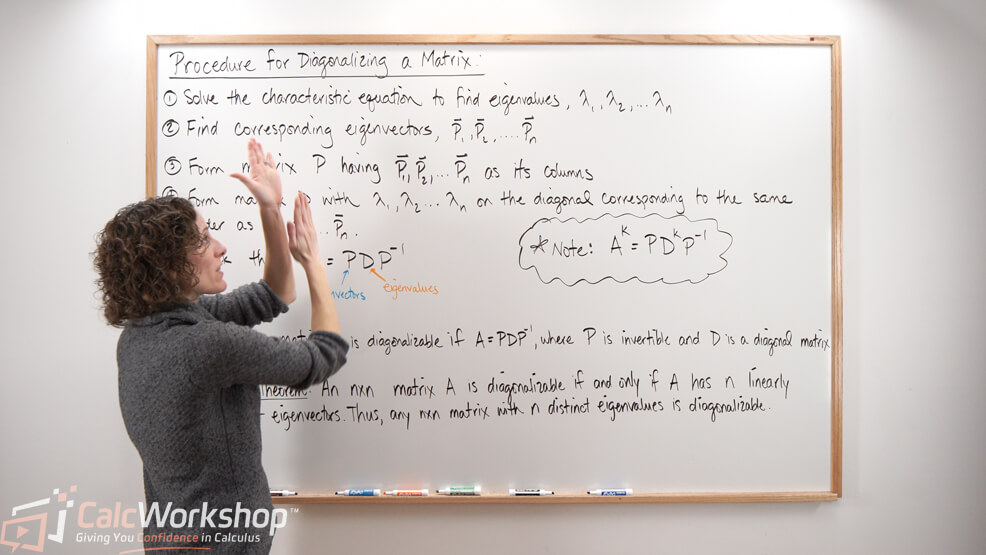If you could name your favorite kind of matrix, what would it be?

Jenn, Founder Calcworkshop®, 15+ Years Experience (Licensed & Certified Teacher)
While most would say the identity matrix is their favorite for its simplicity and how it stays the same when you multiply any matrix by the identity, I will stake my claim and say that my favorite matrix is the diagonal matrix.
Why?
Properties and Importance of Diagonal Matrices
Because diagonal matrices are easy to use and are far-reaching in our ability to find powers of matrices. Additionally, the process of diagonalization helps us to factor or decouple matrices and dynamic systems, analyze eigenvalues and eigenvectors, and helps us to understand fundamental linear transformations.
So, what is a diagonal matrix?
A diagonal matrix sometimes called a scaling matrix, is a square \(n \times n\) matrix that is both upper triangular and lower triangular. In other words, a diagonal matrix is a square matrix whose off main-diagonal entries are all zero.
For example, the following are all diagonal matrices:
\begin{align*}
\left[\begin{array}{cc}
3 & 0 \\
0 & -2
\end{array}\right] \quad\left[\begin{array}{ccc}
-2 & 0 & 0 \\
0 & 1 & 0 \\
0 & 0 & 5
\end{array}\right]\left[\begin{array}{cccc}
a_{11} & 0 & \cdots & 0 \\
0 & a_{22} & \cdots & 0 \\
\vdots & \vdots & \ddots & \vdots \\
0 & 0 & \cdots & a_{n n}
\end{array}\right]
\end{align*}
And what’s so fantastic about diagonal matrices is that we can quickly compute the powers of diagonal matrices, as the example below nicely demonstrates.
Suppose
\[
D=\left[\begin{array}{cc}4 & 0 \\ 0 & -7\end{array}\right]
\]
we are asked to find \(D^{2}, D^{3}\), and \(D^{k}\).
For \(D^{2}\):
\begin{aligned}
D^{2} & = D \cdot D \\
& = \left[\begin{array}{cc}
4 & 0 \\
0 & -7
\end{array}\right]
\left[\begin{array}{cc}
4 & 0 \\
0 & -7
\end{array}\right] \\
& = \left[\begin{array}{cc}
4^{2} & 0 \\
0 & (-7)^{2}
\end{array}\right]
\end{aligned}
For \(D^{3}\):
\begin{aligned}
D^{3} & = D \cdot D^{2} \\
& = \left[\begin{array}{cc}
4 & 0 \\
0 & -7
\end{array}\right]
\left[\begin{array}{cc}
4^{2} & 0 \\
0 & (-7)^{2}
\end{array}\right] \\
& = \left[\begin{array}{cc}
4^{3} & 0 \\
0 & (-7)^{3}
\end{array}\right]
\end{aligned}
For \(D^{k}\):
\begin{aligned}
D^{k} & = \left[\begin{array}{cc}
4^{k} & 0 \\
0 & (-7)^{k}
\end{array}\right]
\end{aligned}
Gosh, wouldn’t it be great if every matrix could be a diagonal matrix? Understanding “complicated” would be so much easier, right?
The Concept of Diagonalization
Well, the idea behind diagonalization is to find out to what extent one matrix behaves like a “simpler” matrix using eigenvalues and eigenvectors.
In truth, a square matrix \(\mathrm{A}\) is said to be diagonalizable if \(\mathrm{A}\) is similar to a diagonal matrix, and the diagonalization theorem tells us how.
The Diagonalization Theorem
The Diagonalization Theorem states that an \(n \times n\) matrix A is diagonalizable if and only if \(\mathrm{A}\) has \(\mathrm{n}\) linearly independent eigenvalues.
In fact, \(A=P D P^{-1}\), with \(\mathrm{D}\) a diagonal matrix, if and only if the columns of \(\mathrm{P}\) are \(\mathrm{n}\) linearly independent eigenvectors of \(\mathrm{A}\).
So, \(\mathrm{D}\) is a diagonal matrix where the main diagonal is the eigenvalues of A and correspond, respectively, to the eigenvectors of \(A\) that are represented in matrix \(\mathrm{P}\).
Example: Diagonalizing a Matrix
Let’s look at an example to help make sense of this, where we will combine our knowledge of the powers of diagonal matrices with the diagonalization theorem.
Suppose \(A=\left[\begin{array}{cc}7 & 2 \\ -4 & 1\end{array}\right]\) and \(\lambda=5,3\) are eigenvalues of A that yield the corresponding eigenspace \(\left\{\left[\begin{array}{c}1 \\ -1\end{array}\right],\left[\begin{array}{c}1 \\ -2\end{array}\right]\right\}\) find \(A^{k}\) if \(A^{k}=P D^{k} P^{-1}\)
First, we will take our eigenvalues, create our D matrix and eigenspace, and write our \(\mathrm{P}\) matrix.
\begin{aligned}
\lambda & = 5, 3 \\
D & = \left[\begin{array}{ll}
5 & 0 \\
0 & 3
\end{array}\right] \\
\text{and} \\
\left\{\left[\begin{array}{c}
1 \\
-1
\end{array}\right],\left[\begin{array}{c}
1 \\
-2
\end{array}\right]\right\} & \Rightarrow P=\left[\begin{array}{cc}
1 & 1 \\
-1 & -2
\end{array}\right]
\end{aligned}
Next, we will find the inverse of our P matrix.
\begin{aligned}
P^{-1} & =\frac{1}{-1}\left[\begin{array}{cc}
-2 & -1 \\
1 & 1
\end{array}\right] \\
& =\left[\begin{array}{cc}
2 & 1 \\
-1 & -1
\end{array}\right]
\end{aligned}
Now, all we have to do is plop our three matrices into our formula, and voila!
\begin{aligned}
A^{k} & =P D^{k} P^{-1} \\
& = \underbrace{\left[\begin{array}{cc}
1 & 1 \\
-1 & -2
\end{array}\right]}_{P} \underbrace{\left[\begin{array}{cc}
5 & 0 \\
0 & 3
\end{array}\right]^{k}}_{D} \underbrace{\left[\begin{array}{cc}
2 & 1 \\
-1 & -1
\end{array}\right]}_{P^{-1}} \\
& = \left[\begin{array}{cc}
1 & 1 \\
-1 & -2
\end{array}\right]
\left[\begin{array}{cc}
5^{k} & 0 \\
0 & 3^{k}
\end{array}\right]
\left[\begin{array}{cc}
2 & 1 \\
-1 & -1
\end{array}\right]
\end{aligned}
With our newfound skills, we can easily raise any square matrix to any exponent. Nice!
Limitations of Diagonalization
Alright, here’s a question: Can any square matrix be diagonalized?
No. Matrix A is diagonalizable if and only if there are enough eigenvalues to form a basis of \(\mathbb{R}^{n}\). Such a basis is sometimes called an eigenvector basis. Consequently, not all matrices can be diagonalized.
As we will find in our lesson, it is not necessary for a square matrix to have distinct eigenvalues to be diagonalizable, but an \(n \times n\) matrix with \(\mathrm{n}\) distinct eigenvalues is always diagonalizable.
Next Steps
In this lesson, you will:
- Learn properties about diagonal and similar matrices
- Understand the process of diagonalizing matrices
- Discover important facts regarding diagonalization, eigenvalues, and eigenvectors
Get ready to dive in and explore!
Video Tutorial w/ Full Lesson & Detailed Examples

Get access to all the courses and over 450 HD videos with your subscription
Monthly and Yearly Plans Available
Still wondering if CalcWorkshop is right for you?
Take a Tour and find out how a membership can take the struggle out of learning math.